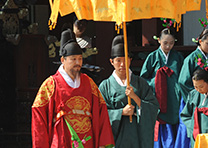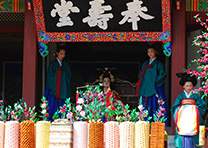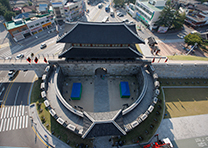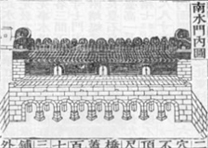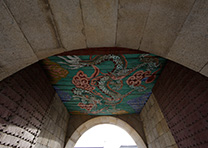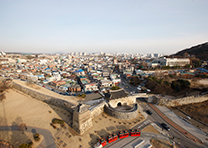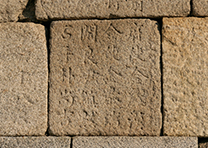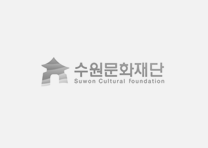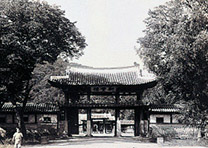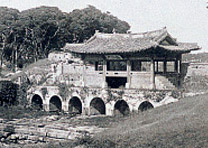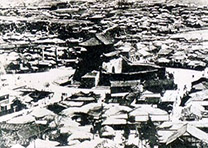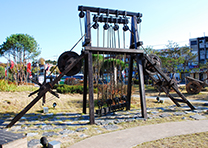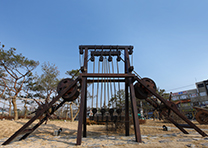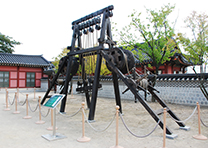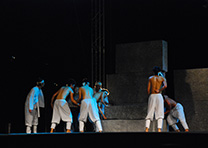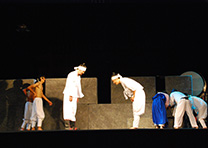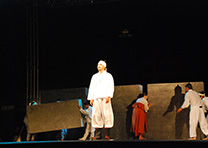The historical background of construction of the Suwon Hwaseong Fortress
Due to his filial piety to his father, Sadoseja, and to find a way to revise the problem-ridden existing power structure around the court, and spend his later years after retiring from the rulership, King Jeongjo decided to build a new city called Sowon, construct the Hwaseong Haenggung, a secondary palace, inside the city, and walls around the city.
Starting from the time when King Jeongjo decided in 1789 (the 13th year of King Jeongjo) to move Yeongwuwon, the tomb of Sadoseja, unfortunate Crown Prince who died a tragic death inside a rice chest as a victim of faction struggles, he took a variety of measures for the residents of Suwon city.
First of all, as the local government headquarters was moved to a new location at the foot of Mt. Paldal, the king arranged that local government buildings and various other facilities and urban infrastructure ― gwana, or administrative and law enforcement facilities, hyanggyo, or educational institution, and urban infrastructure such as yeokcham, or traffic facilities, shopping areas, roads, and bridges, etc. ― should be constructed. He also took measures for those residents who were affected by the government policy. As an example, the people who were residing at the place where the new tomb of Sadoseja would be constructed had to move out. According to Suwon Haji Chorok, local administrative record of the time, the residents (677 persons of 244 houses) were provided with abundant compensations and moving costs.
In addition, the king took special measures like pardoning of all prisoners in Suwonbu and of those who came from Suwon and were exiled to remote places, and reduction of taxes imposed on the Suwon residents. He reduced or exempted land tax and compulsory labor of residents in and around Hwaseong Yusubu. So did he on hwangok, or returning back in harvest season of the grains borrowed in Spring, and gunpo, or cloth tax for military service. In addition, the residents were given various special treatments such as invitations to various parties the king held, awards in various public projects, rice to the poor among the residents, and recruitments of government officials by special gwageo, government examinations, for civil and military officials.
Byeolsi, or special gwageo, was held in every royal tour to the tomb. It was supposed to be taken by students of neo-Confucianism, scholars, soldiers, and other military men. Especially, at the time of the royal tour to the tomb in 1795 (the 19th year of King Jeongjo) when the party celebrating the 60th birthday of Haegyeonggung Ms Hong, the king's mother, the gwageo was held under the king's presence, choosing 5 winners in the civil service part and 56 in the military service part.
In the gwageo held in 1790 (the 14th year of King Jeongjo), it was found that 3 out of successful applicants were not from Suwon. His men suggested that the king send those three applicants to the military camp as punishment. But, he leniently decided to simply cancel their passing the examination.
Professor Choi Hong-gyu says, "Through these special gwageo examinations for civil and military officials, residents of Suwon and its neighboring places could enter the government officialdom. It seems that, in the process of constructing the new city and the fortress, residents enjoyed expanded opportunities to upgrade their social statuses."
It was noteworthy that, in the whole process of moving the city, constructing governmental buildings including the secondary palace, and the fortress, the government recruited workers by paying their wages. In the past, people were forcefully mobilized for such a public service, and they had to give free labor to such a project. Though court officials suggested to mobilize the people or Buddhist monks without paying them, the king did not accept the suggestion and gave the order that workers should be paid.
The king's decision to pay the workers for the project led a huge number of people from across the country to come to Suwon, making the project proceed without any delay. Rather, the problem, after the project was over, was, as Hwaseong Seongyeok Euigwae recorded, how to return the reluctant workers to their hometowns.
To construct a new city equipped with the status as the administrative, military, and commercial center, King Jeongjo decided to promote the industries and commerce of the city by renting as much as 65 thousand nyang from the coffers of the state to Suwon residents, prompting industrial and commercial development of Suwon, and laying the basis on which the city would prosper.
The financial support of 4 thousand nyang by the government made it possible for a paper manufactory to be established in Jiso-dong Bukbu-myeon (currently, Yeonmu-dong Paldal-gu). Bongnyeongsa Temple is known to have been given the role of manufacturing tofu for the meals of workers. Market places were also formed: South Market (also called the Outside the Wall Market. Currently, it is the Yeongdong Market) outside the Paldalmun gate, and North Market (also called the Inside the Wall Market).
King Jeongjo's love of Suwon and his special treatment on its residents tempted a number of people from other regions to move to the city. Especially, when the descendents of Yun Seon-do, famous scholar politician of the dynasty, moved to the city from Haenam, the southern tip of the Korean peninsula, the government prepared the house for them. The then Eight Richmen's House at Bosi-dong (currently Buksu-dong) was the place where merchants who came here from across the country ran commercial activities. It is said that the district name Bosi-dong was created by the fact that the government lent funds to common people and merchants.
The king promoted agriculture as well as commerce and industries. He had reservoirs like Mansekgeo, Chukmanje, and Mannyeonje, etc. and garrison farms constructed, preparing the ground for Suwon to become a center of agricultural science education.
Construction management and fortress administration
What cannot be omitted in describing the construction of the Suwon Hwaseong Fortress is the management and administration ability of the government. It is remarkable to construct the Hwaseong Haenggung Palace, and, at the same time, such a good fortress reaching about 5.7km in the period of as short as 32 months. It would be impossible to do it without the superb ability to manage such a big project. It was possible because the technological, managerial and administrative capabilities were at the peak in those days.
Especially, the managers of the project looks to have been very strict in monetary matters. They used daily wage system and performance-based pay system, probably to prevent the expenses from being leaked out and to encourage workers to boost their efforts. Transparent management and administration are important in any age and any society. When there is a problem in the system, its management and administration become untransparent. Clean and transparent management and administration made it possible to construct the highest-quality fortress in a short period of time.
Establishment of the construction real-name system
The construction of the fortress was performed with a perfect real-name system. The construction report published after the project had been over recorded all the processes from the beginning to the end. The managers of the project seem to have thought that, since it took large amount of national finances and it finished successfully, it was natural to publish such an construction report.
In lunar February 1795 (the 19th year of King Jeongjo) in the lunar calendar when the construction of the Suwon Hwaseong Fortress was in full swing, a great feast was held in Suwon. It was the party to celebrate the 60th birthday of Haegyeonggung Ms Hong, the king's mother. The fact that it was held within the incomplete fortress proves how much emphasis the king put on the fortress. The king had the whole process of the feast recoded in the book, Wonheng Eulmyo Jeongri Euigwe. Before publishing the book, the king established the Jeongri Euigwecheong Office to record all the important national events.
Wonheng Eulmyo Jeongri Euigwe served as a model to publish later the construction report on the fortress. The report titled Hwaseong Seongyeok Euigwe recorded all the process ranging from the discussions among those concerned with the project, official letters exchanged among government organizations, to the king's opinions and orders. It also carried in detail the names of the workers, the number of days each of them worked, location and feature of each facility, and the construction costs. Sketches were used to show what could not be described in letters.
In the section of construction costs, expenses for each part of the project were calculated, and labor costs and the number of days each worker worked were also recorded in detail. Thus, the book made it possible to know, for example, where mason A came from, how many days he worked in which work places, and how much he was paid.
Materials used for any facility were recorded item by item, and the costs were calculated. To help readers grasp them clearly, the book provided sketches of facilities both from inside and from outside of the walls. And, in inevitable situations, the book provided the sketches of the interior of facilities. For machines like geojunggi, it even explained parts of it with sketches separately, which proves that the report was not made superficially.
In the 1970s, the Suwon Hwaseong Fortress was under large-scale repairs, and has continuously been under small-scale ones. In those cases, the Hwaseong Seongyeok Euigwe served as the criteria on guiding how it would be repaired. The report also served its role in influencing the UNESCO to decide to choose the Suwon Hwaseong Fortress as a World Heritage. Those of UNESCO were impressed to find out that a perfect construction report had been made about 200 years.
While the real-name system contained in the Hwaseong Seongyeok Euigwe is impressive, we can identify the traces of the real-name system in the sites in three of the wall gates: Changyongmun, Hwaseomun, and Paldalmun gates. On each of the gates, there is the plate on which the names of workers who participated in the construction of the gate were written. While it is difficult to recognize the names on Hwaseomun gate, we can identify the names on plates of the other two gates. Especially, the names on the plate of the Paldalmun gate are clear as if they were written just yesterday.
Such a practice where workers were ready for their jobs by recording their names is really surprising, compared with recent careless construction cases where no one wants to be responsible. Leaving records behind is really important, because one will not leave records on what one does unless one is proud and confident of it. The fact that King Jeongjo and other government officials left records on the whole process of constructing the fortress means that they were confident of what they were doing. What would have been the origin of such proud confidence? It must have been derived from their love of the people.
Procurement of materials in constructing the fortress
Ever since the transfer of the capital from Keseong to Seoul in the 1390s after the change of dynasty from Koryeo to Joseon, and the construction of new palaces, government buildings and city walls, it was the biggest national construction project. Therefore, needless to say, it must have required huge amount of various materials.
The project mangers needed incalculable amounts of various materials ranging from the direct materials necessary to build the fortress such as stone, bricks, wood, and various irons, to indirect materials such as food to feed the workers, firewood to cook meals, to transportation means like carts and cows and horses, to paper, writing brushes, and ink needed in recording the construction process, to tools and materials like colors, straw bags, charcoal, cord, machine tools, lime, and oil, etc.
urprisingly, the Hwaseong Seongyeok Euigwe jotted down all the items, the unit number or quantity of each item, unit price, and the place where they were procured for even such trifling things as spoons, jots, bowls, gourd bowls for measurement, scales, scoops, besom brooms, kettles, and straw bags, etc. in addition to the materials mentioned above.
According to the report, the total cost including expenses for procuring materials and labor costs in building the fortress was 873,517.79 nyang. Book 5 and 6 of the report are on materials, which list all the kinds and number or quantities of materials used in constructing the fortress, and the list of materials and unit prices used for building the fortress and other facilities. As a reference point, daily wage for an adult non-professional worker was 0.25 nyang.
The project managers are found to have bought the houses located at the places where the fortress would be constructed, paying the house owners generously. For example, according to the report, they paid 15 nyang buying the thatched 5-room house owned by Song Bok-dong at Buk-ri district. (They paid 10 nyang as additional price, which seems to have been compensation fee.) Then, we can calculate now that at that time a non-professional worker had to work for about two months to buy a 5-room house, though there must have been differences in house price depending on the conditions of houses. And, through such calculation, we can guess the value of money at that time.
According to the report, the price of 1 sum of rice (1 sum = 15 mal (1 mal = 18 liters)) was about 5 nyang. A cow was 20.35 nyang, a roll of cotton cloth was 2 nyang. 1 seok of charcoal was 0.63 nyang, 1 geun (600g) of beef priced 0.5 nyang, and a pig was 5.34 nyang. Those writings are valuable data for us to know the situation of products and their prices in the 18th century, as well as the expenses inputted in constructing the fortress.
Then, how were the stones, the most frequently used material in constructing the fortress, secured, and how were they transported? At the symposium held on November 24, 2012, jointly by the Jindan Scholastic Association and the Gyeonggi Cultural Foundation to comprehensively examine the Hwaseong Seongyeok Euigwe, professor Jo Byeong-ro at Gyeonggi University revealed that all the stones used to construct the fortress were 201,403 pieces, and, if they were converted to monetary value, it was 136,960.9 nyang.
These stones were acquired from nearby mountains like Mt. Sukji, Mt. Yeogi, Mt. Paldal, and Gwondong, not from faraway mountains.
Mt. Sukji was located in the administrative unit called Gongseok-myeon at that time. On the way to return to the palace form Suwon on January 24, 1796, King Jeongjo was told by Che Je-gong that it had been discovered that Mt. Sukji was an abundant source of hard stones. "Who would have known that so many good stones are discovered at the mountain today to be used for building the fortress, and the mountain would be emptied?" exclaimed the king. Mt. Sukji is currently the mountain of Hwaseo-dong behind Yeongbok Girls' High School.
Even now, here and there in Mt. Sukji and Mt. Paldal, we can identify the evidences of stones having been cut off. The spot where stones were cut off was called 'buseokso', or quarry. From various quarries of those mountains, 189,400 pieces of stone in total were cut off: 81,100 pieces from Mt. Sukji, 62.400 from Mt. Yeogi, 32,000 from Gwondong, and 13,900 from Mt. Paldal. It is not much exaggeration to say that most of stones used in constructing the fortress were from those four places.
The stones cut off from quarries were sent to chiseokso, or stone-trimming place, to trim them to certain standards. Especially, stones for piling up for the walls were standardized into three grade: large, medium, and small. Trimmed stones were moved to the construction sites.
To transport stones, roads were built, following the order of King Jeongjo to build "roads as straight as arrows and as flat as whetstone." Stones were transported by the following vehicles: daegeo, the big cart, hauled by 40 oxen; pyeonggeo, the middle cart, hauled by 4~8 oxen; balgeo, the small cart, hauled by 1 ox; donggeo, baby cart hauled by 4 adult men. Sledge was also used. A new type of cart called yuhyeonggeo was manufactured as a model, and it was what would remedy defects of daegeo and sledge.
Cart-pulling oxen should be big and healthy, and strong in legs. The managers sent military officers to various counties to buy such oxen there with cooperation with military officers of those counties. 608 oxen were bought and used in constructing the fortress: 309 oxen from Gyeonggi province, 50 from Hoseo region, 80 from Gwandong region, and 167 from Heseo. For other purposes, 80 oxen and 252 horses were used.
Timber was used to build the followings: four wall gates (Janganmun, Paldalmun, Hwaseomun, and Changrongmun); Dongjangdae and Seojangdae; various poru, gakru, and posa. 26,206 pieces of timber were used, which could be converted to a monetary value of 4,902.55 nyang, small amount compared with 136,960 nyang for stones. However, securing timber that would be used for pillars and rafters took up an important portion in fortress construction.
The timber was cut from across the country: Anmyendo island of Chungcheong province; Jangsangot cape of Hwanghae province; the regions along the Han river in Gyeonggi and Gangwon provinces; Suncheon, Gwangyang, Heungyang, Gure, Bangdapjin, Sadojin of the Jwasuyeong region of Jeolla province; Jaju, Jindo, Jangheung, Ganjin, Muan, Heungdeok, Gimje, Wando of the Wusuyeong region of Jeolla province; Gwangju, Namyang, and Gwangpyeong of Gyeonggi province; and others. In those days, the mountain from which trees were cut by the central government was designated as 'geumyangcheo', or 'bongsan'. Cutting trees by private person in such a mountain was strictly prohibited, and anyone who violated it was punished severely.
According to the Hwaseong Seongyeok Euigwe, the timber was transported by barge or raft. Those timbers from Chungcheong, Hwanghe, and Jeolla provinces were moved on sea by military ships in each port garrison or fishing boats of common people, and the timbers cut from areas along the Han river were moved by raft on river, and, when those rafts arrived at sea, timber was transferred to ship.
The timber transported on sea route arrived at the chimokso, or timber-trimming place, at Gupo (currently Gupo-ri on the Sihwa Lake in Suwon city) to be trimmed, and then was moved to each construction site. Superintendents and carpenters at the chimokso trimmed timber in different ways, and had timbers moved to Suwon by carts. The project managers made various efforts for timber transport including road repairs.
Needless to say, those who cut, transported, or trimmed timber were paid for their labor. Tree-cutters and transporters were paid from 0.1 nyang or 1 jeon to 0.5 nyang for one tree.
To build the fortress, a large amount of iron was needed besides stone and timber. 559,031.93 geun of iron, 2,860 units of iron leaf (metal decoration attached on the gate which looked like fish scale), and iron tools were used in the construction process, equivalent to 86,215.71 nyang in monetary value. Those iron materials were also procured by allocating them to different provinces, and and transported by ship. Part of them were bought from private merchants.
Meanwhile, a large amount of bricks and roofing tiles were needed as well. Bricks were baked in Suwon by inviting technicians from across the country. At first, bricks were baked at the klin ('Wabyeokso') at Wangryn. Later, two more klins were built: one to the north of the fortress, and the other at Mt. Seobong, Seobong-dong, Jeongnam-myeon, Hwaseong city. consequently, there were three klins to bake bricks.
It costed 26,577.15 nyang to manufacture bricks for constructing the fortress. Roofing tiles were manufactured at klins (Beonwaso) of Wangryun, Seobong, and Sagwanpyeong (or Sageunpyeong), costing 6,198.36 nyang.
Firewood used to bake bricks and roofing tiles were bought from privately owned mountains near the construction sites. Other materials included charcoal, lime, colors, paper-writing brush-ink, and other miscellaneous things. 69,056 straw bags of charcoal were bought from Jipyeong, Gwangju, and Yongin, Gyeonggi province. Lime was baked at various places like Paju and Pungdeok, and Eorangcheon of Suwon, Gyeonggi province, and Pyeongsinjin, Chungcheong province. A large amount of lime from Geumcheon, Hwanghe province was transported to Suwon by ship.
Most of paper was procured at paper shops in Seoul. But, in 1795 (the 19th year of King Jeongjo), the project managers established Jiso, or paper factory, at the entrance of Gwanggyo-dong (Yeonmu-dong), and had monks who possessed related techniques manufacture paper. The area near the Suwon Cross-country Bus Terminal is still called 'Jiso' or 'Jiswe'. Other miscellaneous things are too diverse and numerous to list them all here.
They were more than 140 miscellaneous items including 1,870 pieces of cowhide, 59,600 straw bags, 391,986 fathoms of straw rope, 6,075 geon of boiled jute for making rope, 2,852 dongi 49 geun of raw arrowroot for transporting stone, 108,432 bundles of firewood, 242,284 bundles of rice straw, 74 whetstones, 86 big and small kettles, and 71 big pots, etc. All of them costed 123,744.14 nyang. All the details are recorded in the Hwaseong Seongyeok Euigwe. The spirit of recording everything of our ancestors are worth respecting.
Geojunggi
During the years of King Jeongjo in the early 18th century Joseon, it must have been not easy to construct a fortress like Suwon Hwaseong. Convenient, efficient, and effective machines may have been needed. Geojunggi was devised to satisfy such a necessity. Considering the civil engineering level of those days, the secrets of having been able to build such an elegant, strong fortress with relatively low costs in a short period of time, two and half years, can be found in the experiences and wisdom of so superb silhak scholars like Bangae Yu Hyung-won and Dasan Jeong Yak-yong, and uses of various machines and tools like geojunggi.
While they applied foreign technologies and manufactured and used machines like geojunggi, probably the fact that they could acquire a large amount of stone from nearby places and bake bricks also may have contributed to the success of the project.
Especially, King Jeongjo asked the Joseon envoy to China to procure in Beijing Sagojenseo, to get knowhow of fortress construction. The envoy could not find the book Sagojenseo, but bought 5,022 books of Gogeum Doseo Jipseong, or the Collection of Old and New Books, by paying as much as 2,150 nyang. Jeong Yak-yong, devised geojunggi with golcha, referring to Gigidoseol of the collection of the books. People were surprised when the geojunggi lifted a stone as heavy as 25,000 geun, which was 625 times heavier than the power of geojunggi, 40 geun.
Major defence facilities in the whole structure of the fortress was built by piling up bricks. King Jeongjo decided and frequently checked the construction process, letting the experts in various fields display their expertises. As a result, the Suwon Hwaseong Fortress, brick fortress and which is called the flower of fortresses in Joseon dynasty, was born.
Payment of wages
Before modernization, it was common to mobilize the people for the public projects the national government and local offices implemented. In many cases, the government did not pay the workers and forced harshly them to work, angering the people, and occasionally stimulating them to start riots. But, it was not the case in the project of constructing the Suwon Hwaseong Fortress.
The King not only made all the wages paid strictly, but from time to time would award prizes and hold parties. In hot summer, he would prescribe and distribute to workers the pill called cheokseodan, medicine to give energy to body.
According to the records, as there were so many people who came to the new city construction sites from around the country that the king gave a special order to local officials that they prevent residents from coming to Suwon.
To requisition people and ask them to work for a public project was called buyeok. Buyeok was so burdensome to people that, in later years of the Joseon dynasty, some people would pay with goods for working in the project. When the construction of the fortress began, Che Je-gong also argued that people should be requisitioned for the project without paying wages, citing previous cases. According to the record of May of the 18th year of King Jeongjo, book 40, King Jeongjo Silrok, Che said as follows.
Confucius mentioned that "people should be properly asked to work for the public project." He didn't prohibit mobilization of people, did he? Since this project is a great national project, there is no choice but to ask the people to provide their labor to the project. It is also their duty to provide buyeok. But, Your Highness, out of love of the people, has not yet given the order to mobilize the people. Don't Your Highness think that, if you love people, you should make them work? Especially, Buddhist monks are suitable for mobilizing for this project. So, it seems inevitable to mobilize monks and the people to work for the project for a few days, considering the distances of their living places from the construction site.
Che was not the only official who argued the necessity of mobilizing the people for the project. Vice premier Lee Byeong-mo also suggested to allocate the numbers of workers who would work for the project to different provinces. Most officials including another vice premier Kim I-so, Hengpanjungchubusa Kim Hi, Hengyejopanseo Jeong Chang-sun, Hengsajik Hong Yang-ho, Jeonchami Yun Heng-im, Jwachamchan Hong Subo, and Pandonnyeongbusa Kim Ji-muk, etc. also supported the idea of forceful mobilization.
But, the king did not agree on the idea of forceful mobilization. According to 'Hwaseong Gijeokbi' in the Hwaseong Seongyeok Euigwe, the number of workers put in the fortress construction was more than 700 thousand in total, and all were paid. The people were not asked to give three-day service to the government project which was stipulated by law. All workers participated in the construction in their own wills.
But, inevitable artisans like mason, carpenter, experts of roofing tiles and bricks, plasterer, blacksmith, sculpturer, etc. were requisitioned by buyeok. They were also paid, and, in some cases, were treated as specialists by paying more than simple workers.
While simple worker was paid about 0.25 nyang a day, carpenter, plasterer, sculpturer, picture-drawer, and cart-hauler, etc. were paid about 0.42, according to the Hwaseong Seongyeok Euigwe. At that time, 1 sum (15 mal) of rice was traded as about 5 nyang. Mason, with one assistant, was paid 0.45 nyang and 6 doe (0.477 US gallon. 10 does equal 1 mal.) of rice a day.
The total number of artisans mobilized for the project was 1,821, participating in various constructions for 3,111,131 days in total. The sum of wages paid to them was 128,735.43 nyang. Wages paid to masons were 73,164 nyang, taking up 52.3%, the largest portion, followed by those paid to plasterers, 24,419.7 nyang (19%); those to carpenters, 13,381 nyang (10.4%); and those to blacksmiths, 10,745.87 nyang (8.3%).
On the other hand, the wages paid to mogun, simple workers, were 117,520.87 nyang, and those paid to damgun, transporters of timber or stone, were 58,561.57 nyang. And, the total sum of wages to all types of workers in the project reached 304,817.84 nyang. We can guess the proportion of wages for the project, by comparing them with the expenses paid to procure materials like timber and stone, 390,201.11 nyang.
Meanwhile, for the workers who came from distant places, temporary houses were built near fortress construction sites like Paldalmun and Janganmun, Mt. Sukji and Mt. Yeogi where stones were cut off, and Gupo (current Bibong-myeon, hwaseong city) where timber was trimmed, etc. and, when workers fell ill, they were treated at camps outside of the fortress, and paid 1 doe of rice and 0.1 yang a day while they were under treatment and did not work.










